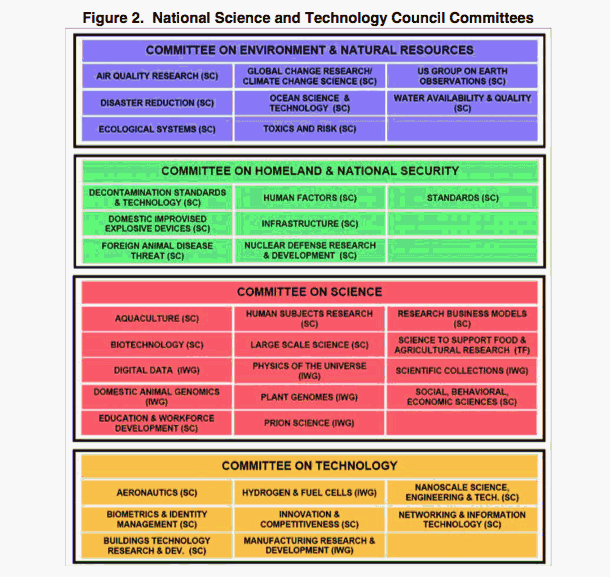No edit summary |
No edit summary |
||
| Line 2: | Line 2: | ||
| − | The '''[http://www.whitehouse.gov/administration/eop/ostp/nstc/about National Science and Technology Council]''' ('''NSTC''') was established on November 23, 1993, by [[Executive Order 12881]].<ref>Executive Order 12881, “Establishment of the National Science and Technology Council,” 58 Fed. Reg. 226, Nov. 23, 1993, at 62491.[http://www.archives.gov/federal-register/executive-orders/pdf/12881.pdf] The executive order stated that NSTC will oversee the [[Federal Coordinating Council for Science, Engineering, and Technology]] ([[FCCSET]]), the National Space Council, and the National Critical Materials Council, none of which have been active since the NSTC was created.</ref> According to the executive order, NSTC |
+ | The '''[http://www.whitehouse.gov/administration/eop/ostp/nstc/about National Science and Technology Council]''' ('''NSTC''') was established on November 23, 1993, by [[Executive Order 12881]].<ref>Executive Order 12881, “Establishment of the National Science and Technology Council,” 58 Fed. Reg. 226, Nov. 23, 1993, at 62491.[http://www.archives.gov/federal-register/executive-orders/pdf/12881.pdf] The executive order stated that NSTC will oversee the [[Federal Coordinating Council for Science, Engineering, and Technology]] ([[FCCSET]]), the National Space Council, and the National Critical Materials Council, none of which have been active since the NSTC was created.</ref> According to the executive order, NSTC works as a "virtual agency" to coordinate the S&T policy-making process; ensure science and technology policy decisions and programs are consistent with the President’s stated goals; help integrate the President’s S&T policy agenda across the federal government; ensure S&T is considered in the development and implementation of federal policies and programs; and further international S&T cooperation. |
An important objective of the NSTC is the establishment of clear national goals for Federal science and technology investments in areas ranging from [[information technologies]] and health research, to improving transportation systems and strengthening fundamental research. The Council prepares [[research and development]] strategies that are coordinated across Federal agencies to form investment packages aimed at accomplishing multiple national goals. |
An important objective of the NSTC is the establishment of clear national goals for Federal science and technology investments in areas ranging from [[information technologies]] and health research, to improving transportation systems and strengthening fundamental research. The Council prepares [[research and development]] strategies that are coordinated across Federal agencies to form investment packages aimed at accomplishing multiple national goals. |
||
| Line 14: | Line 14: | ||
[[Image:NSTC.gif]] |
[[Image:NSTC.gif]] |
||
| − | ::Source: National Science and Technology Council |
+ | ::Source: National Science and Technology Council [http://www.ostp.gov/cs/nstc/committees website]. |
::Note: SC = subcommittee; IWG = interagency working group; TF = task force. |
::Note: SC = subcommittee; IWG = interagency working group; TF = task force. |
||
Revision as of 17:52, 3 December 2011
Overview
The National Science and Technology Council (NSTC) was established on November 23, 1993, by Executive Order 12881.[1] According to the executive order, NSTC works as a "virtual agency" to coordinate the S&T policy-making process; ensure science and technology policy decisions and programs are consistent with the President’s stated goals; help integrate the President’s S&T policy agenda across the federal government; ensure S&T is considered in the development and implementation of federal policies and programs; and further international S&T cooperation.
An important objective of the NSTC is the establishment of clear national goals for Federal science and technology investments in areas ranging from information technologies and health research, to improving transportation systems and strengthening fundamental research. The Council prepares research and development strategies that are coordinated across Federal agencies to form investment packages aimed at accomplishing multiple national goals.
In contrast to its predecessor, the Federal Coordinating Council for Science, Engineering, and Technology (FCCSET), which was chaired by the OSTP Director, the NSTC is chaired by the President. Many of the NSTC members are cabinet officials. In practice, the NSTC has rarely had a meeting with the President or cabinet-level officials present. Rather, OSTP staff and detailees[2] manage NSTC activities in conjunction with federal agency staff.
Committees
Currently, the NSTC has four primary committees: Science; Technology; Environment and Natural Resources; and Homeland and National Security. Each NSTC committee has subcommittees, interagency working groups, or taskforces focused on specialized topics. The membership of these committees and subcommittees are generally not cabinet officials, but instead lower ranking staff.
- Source: National Science and Technology Council website.
- Note: SC = subcommittee; IWG = interagency working group; TF = task force.
References
- ↑ Executive Order 12881, “Establishment of the National Science and Technology Council,” 58 Fed. Reg. 226, Nov. 23, 1993, at 62491.[1] The executive order stated that NSTC will oversee the Federal Coordinating Council for Science, Engineering, and Technology (FCCSET), the National Space Council, and the National Critical Materials Council, none of which have been active since the NSTC was created.
- ↑ A detail is an officially approved temporary assignment of a civil service employee (called informally a “detailee”) to a different position in another federal agency. The employee’s official title, series, grade, rate of compensation, or permanent employer does not change.
